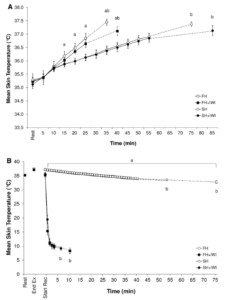 Flouris AD, Wright-Beatty HE, Friesen BJ, Casa DJ, Kenny GP. Treatment of exertional heat stress developed during low or moderate physical work. Eur J Appl Physiol. 2014 Dec;114(12):2551-60. doi: 10.1007/s00421-014-2971-1. Epub 2014 Aug 15. PMID: 25118838.
Flouris AD, Wright-Beatty HE, Friesen BJ, Casa DJ, Kenny GP. Treatment of exertional heat stress developed during low or moderate physical work. Eur J Appl Physiol. 2014 Dec;114(12):2551-60. doi: 10.1007/s00421-014-2971-1. Epub 2014 Aug 15. PMID: 25118838.
Abstract:
Purpose: We examined whether treatment for exertional heat stress via ice water immersion (IWI) or natural recovery is affected by the intensity of physical work performed and, thus, the time taken to reach hyperthermia.
Methods: Nine adults (18-45 years; 17.9 ± 2.8 percent body fat; 57.0 ± 2.0 mL kg(-1) min(-1) peak oxygen uptake) completed four conditions incorporating either walking or jogging at 40 °C (20 % relative humidity) while wearing a non-permeable rain poncho. Upon reaching 39.5 °C rectal temperature (Tre), participants recovered either via IWI in 2 °C water or via natural recovery (seated in a ~29 °C environment) until T re returned to 38 °C.
Results: Cooling rates were greater in the IWI [Tre: 0.24 °C min(-1); esophageal temperature (Tes): 0.24 °C min(-1)] than the natural recovery (Tre and Tes: 0.03 °C min(-1)) conditions (p < 0.001) with no differences between the two moderate and the two low intensity conditions (p > 0.05). Cooling rates for T re and T es were greater in the 39.0-38.5 °C (Tre: 0.19 °C min(-1); Tes: 0.31 °C min(-1)) compared with the 39.5-39.0 °C (Tre: 0.11 °C min(-1); Tes: 0.13 °C min(-1)) period across conditions (p < 0.05). Similar reductions in heart rate and mean arterial pressure were observed during recovery across conditions (p > 0.05), albeit occurred faster during IWI. Percent change in plasma volume at the end of natural recovery and IWI was 5.96 and 9.58%, respectively (p < 0.001).
Conclusion: The intensity of physical work performed and, thus, the time taken to reach hyperthermia does not affect the effectiveness of either IWI treatment or natural recovery. Therefore, while the path to hyperthermia may be different for each patient, the path to recovery must always be immediate IWI treatment.
Full Text Link:
https://pubmed.ncbi.nlm.nih.gov/25118838/
![]()
